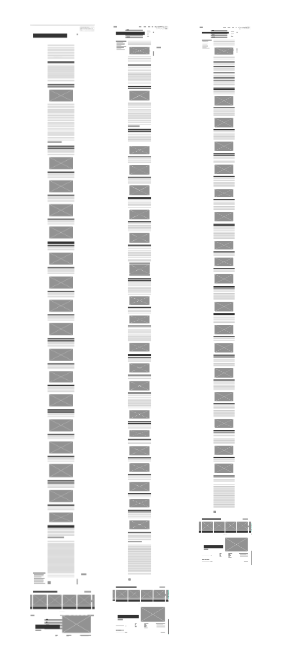
The Dangerous Templated-Scaled Content Abuse Increasingly used by SEO Agencies and Consultants

If you work in SEO, you NEED to know about the rise of the ‘thinly-templated content scaling‘ SEO tactic. You need to know how and why it has worked, and how dangerous it is if you adopt it. Resist!.
While doing some competitor research, I spotted a recurring, interesting, and murky SEO tactic that I feel is not only going to fail soon, but also fail spectacularly. I’ve seen it creeping up this past year or more, while increasingly gaining traction. Perhaps I should have written this sooner…
And the fallout will be huge.
To digital agencies/consultants doing this to the extreme, it could be akin to Panda or Penguin levels of destruction for their own (and client) websites.
This is largely because – time after time over the past two decades – many SEOs think that they are cleverer than the hivemind that is Google’s engineers. They are not. And not only do they think they are cleverer, they also cannot keep their mouths shut. And this means that their ‘secret weapon’ then gets copied by other SEOs until the tactic reaches such a peak that Google HAS to act.
Well, we arrive at the door of Google being able to detect and destroy one of the latest (currently successful) tactics. So, what is it?
It’s what I am calling “thinly-templated content scaling” (TTCS).
The short explanation: Organically-written EEAT-filled clusters of 10-100 web pages that vary very little from a ‘winning formula’ base keyword. Each page in the cluster reads well, and on its own, is usually somewhat useful to the visitor. The pages, however, have a distinct lack of diversity in myriad facets such as page structure, lexicon and design. In some cases, each page will link out to several competitors and/or co-conspirators. SEOs form these clusters to create a stronger site as a whole, as it (up until now?) has been working very well indeed.
Essentially, SEOs (and for the record, many SEO agencies seem to be doing this) find a formula in which they can get decent results by producing a piece of content in a particular way. Nothing wrong with that. But, like thousands of SEOs in the past 20 years, they lose their composure JUST when they need to keep it.
What do they do? They rinse and repeat the same template, but for an ever-so-slightly different subject matter. Perhaps upwards of a hundred pages or more (sometimes many more). Until they have strangled the dear life out of the topic. And they go on repeating it. Until it gets to dangerous levels – which is where we are at right now.
“Scaled Content Abuse” is not just AI Content
In the March 2024 core update page from Google, they say:
Scaled content abuse is when many pages are generated for the primary purpose of manipulating Search rankings and not helping users. This abusive practice is typically focused on creating large amounts of unoriginal content that provides little to no value to users, no matter how it’s created.
Initially, I thought that this was mainly aimed at the naughty boys and girls that have been ramping up AI content production on stupid levels. You have seen these guys on LinkedIn and Google promoting their services (using non-AI content, ironically).
But then it dawned on me.
Google is now more than aware of the ‘thinly-templated content scaling’ practices being committed by SEOs around the world.
The scale of this tactic has reached a point now where Google knows that it must do something about it.
And it will. And many SEO careers will be harmed. Just like with Panda, Penguin, and many other Google ass-kickings. Whether it will be as big as those aforementioned updates remains to be seen, but for some publishers, agencies, consultants, it is going to be horrific.
You may be thinking that this kind of tactic has been around for a long time, and you would be right. But what Google is taking aim at here is those consultants and agencies that have improved the quality of such tactics by adding elements of scale AND finesse – and try to make it look like it is NOT scaled and part of a ‘factory effort’.
The tactic has worked very well so far for several agencies and freelance SEOs, but to the detriment of Google search results in general. And you don’t want to get in the way of Google’s goal of producing excellent results, as this is where its shareholders get their pocket money from.
While Google calls it ‘scaled content abuse’, I would suggest that instead, you do indeed think of it as ‘thinly-templated content scaling’. In the vast majority of cases in my research, the elements letting the application of this tactic down are the extremely similar page designs, page architecture, and content flows of the pages in a cluster.
If it quacks like a duck, and walks like a duck, it’s a duck
Simply put, AI/some code by Google can easily determine that these clusters are exactly what they seem. Once Google has its sights on something like this, it will find a way.
A good way to visualise how Google will attack this problem is as follows:
Imagine a website employing TTCS, and imagine that each page in the cluster doesn’t have a white background, but a transparent background.
Next, imagine each page has been printed on a transparent sheet of acetate. Now, if you put all those sheets on top of each other, you will see that there is a huge similarity between all of those pages. From perhaps word count, to similar title lengths, similar imagery, and a lack of diverse features. They would homogenise into an average.
And the more average that a cluster of pages are, the easier it is for Google to determine scaled content abuse.
Another way to think about it… remember those images on news websites where thousands of faces are overlaid to depict what the average UK male or female looks like, that’s similar to how Google works in countering such tactics.
If it all looks the same, there is a much higher chance that this site is scaling content in a way that improves its own rankings, but doesn’t add so much value to the user.
Content writers that have been tasked with producing this content are probably great at adding E-E-A-T (expertise, experience, authority, trustworthiness) aspects to the content no doubt. They are probably great at using a varied lexicon of words (including SEO keywords). But great content writers are also usually terrible at coding and designing WordPress page templates that accommodate various structures and flow on each page.
So, if you do want to implement such tactics, and stay undetectable forever, then your page templates need to be WILDLY different to each other for a start.
That includes design, similarities/locations of headings, content length, per-page lexicon usage (an easy thing to check for Google), and much more. Essentially, you’re going to have to put a LOT more effort in than the examples I have seen.
|
It’s Much Cleverer than Before
The content on these thinly-templated clusters – if you were to read just one page of it – is usually adequate enough, and in many cases, a very good, and useful read. In fact, in most cases that I have checked, the content is almost certainly created by a human with a good degree of writing quality.
And from what I have seen when researching, it’s usually the best content writer at a company that has written at least the most important pages of a cluster. This person is probably so good in-fact, they are asked by increasingly-excited SEOs to “do it again, do it again”, and more pages in the cluster are added.
History Doesn’t Repeat, it Rhymes
I have been in the field of SEO since 2001. Over that time, I have seen dangerous SEO trends come and go (well, explode in many cases). Some of these trends – when looking back – make perfect sense why they would initially work, and then ultimately fail. These tactics were able to exploited, but then people copied it too much, Google results became poorer, Google acted, and the trend was annulled.
Some of these new types of SEO tactic findings, and whispers about them that you hear at SEO events, can be intoxicating. Things are said at digital sector meetups by over-excited, loose-lipped SEOs, such as
“We’re doing something that Google loves, and we can do it at scale. It’s something that will work forever.”
But as always with networks of humans, there are always bad eggs. They smell money, and they think it’s time to ‘ramp it up a little’. Then a bit more. Then they may fall out with a colleague, who then goes to join another SEO agency. And that colleague, in their first few weeks, cannot hold their excitement. They tell their new colleagues of a ‘sure-fire way of ranking really well while undetected’.
See the pattern here and how these techniques spread like a virus?
The Rise of the SEO Content Scaler Superstar
I have seen the rise of several SEO Superstars, especially on LinkedIn, in the past few years. Some of these people are extremely good indeed. But the majority either have just one (currently working) trick/tactic, or have no real expertise at all. Those that have no real expertise merely follow whatever the most currently popular SEO is doing at the time, while pretending to be an expert. You know who they are.
The most dangerous type of SEO Superstar, in my opinion, is the SEO consultant that has just one tactic – such as say, ‘TTCS’.
I have recently seen at least six different supposed SEO experts on Linkedin effectively selling exactly the TTCS tactic – this tactic alone – in a consulting capacity.
And as you can tell from this article so far, this is more than certainly on Google’s radar. It has reached such a point that it will only get worse from here. I suspect it will still work well for a time. Maybe even a year or more. However, there will be one day when it all comes crashing down. A lot of people are going to be stung. A lot of search agencies and SEO consultants will have to scramble to find something else to sell to their clients.
Keep on Clustering – That’s not the Problem
You should of course keep building great content clusters on your sites. Create great content that solves problems, and brings prospects to your door. Never stop doing this.
And you know what, you may even want to ‘ramp it up a bit’. Again, nothing wrong with this. If you have the resource, and want more leads, create more great content that helps people.
What you should not do, however, is to do it at the expense of true, raw, effort – and turning the creation of content clusters into a ‘sausage factory’. Don’t do something silly and produce a 30-page cluster of content that contains page titles such as:
- The best 39 SEO Companies in Manchester
- 18 of the best SEO Agencies in Leeds
- 11 great SEO Agencies in London
…with content that may be handwritten and useful on its own, but follows a lazy templated pattern. This method is going to cause you all manner of problems when Google really gets its teeth stuck in to the problem.
You have been warned.
One final thing…
The thinly-templated content scaling tactic is used by many of the top 20% (for now) sites in many sectors, with finance, various SaaS, publishing, and digital agencies being some standout examples.


 An example of thinly-templated cluster scaling
An example of thinly-templated cluster scaling

